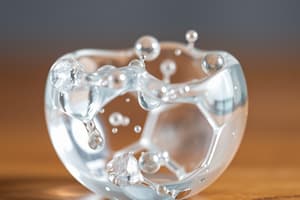Podcast
Questions and Answers
Which property describes how well a substance can dissolve in a liquid?
Which property describes how well a substance can dissolve in a liquid?
- Solubility (correct)
- Thermal conductivity
- Magnetic properties
- Density
Which of the following is true regarding ferromagnetic materials?
Which of the following is true regarding ferromagnetic materials?
- They are not attracted to magnets.
- They include elements like Au and Zn.
- They have a low density.
- They are attracted to magnets. (correct)
How are extensive properties characterized?
How are extensive properties characterized?
- They remain constant regardless of measurement.
- They increase with the amount of matter present. (correct)
- They are independent of the amount of matter present.
- They are always measurable quantities.
Which of the following materials is nonferromagnetic?
Which of the following materials is nonferromagnetic?
What characteristic does the phrase 'like dissolves like' refer to?
What characteristic does the phrase 'like dissolves like' refer to?
Which of the following is a characteristic of homogeneous mixtures?
Which of the following is a characteristic of homogeneous mixtures?
Which example best represents a heterogeneous mixture?
Which example best represents a heterogeneous mixture?
What distinguishes a compound from a mixture?
What distinguishes a compound from a mixture?
Which of the following is NOT a physical property of matter?
Which of the following is NOT a physical property of matter?
What defines a colloid?
What defines a colloid?
Which of the following is an example of a suspension?
Which of the following is an example of a suspension?
What is the primary purpose of a test tube rack?
What is the primary purpose of a test tube rack?
Which best describes a pure substance?
Which best describes a pure substance?
Which laboratory tool is primarily used to clean test tubes?
Which laboratory tool is primarily used to clean test tubes?
What is a key feature of physical changes in matter?
What is a key feature of physical changes in matter?
What is a secondary function of the stirring rod?
What is a secondary function of the stirring rod?
How does a magnetic stirrer work?
How does a magnetic stirrer work?
What are spatulas used for in a laboratory setting?
What are spatulas used for in a laboratory setting?
What is the function of a mortar and pestle?
What is the function of a mortar and pestle?
What is the purpose of using a funnel in a laboratory setting?
What is the purpose of using a funnel in a laboratory setting?
What might be an incorrect use of a stirring rod?
What might be an incorrect use of a stirring rod?
What technique is used to separate soluble solids from solvents?
What technique is used to separate soluble solids from solvents?
Which separation technique is appropriate for separating two immiscible liquids?
Which separation technique is appropriate for separating two immiscible liquids?
What is the primary purpose of centrifugation in separation techniques?
What is the primary purpose of centrifugation in separation techniques?
Which technique is best for separating liquids with different boiling points?
Which technique is best for separating liquids with different boiling points?
Which method would be ineffective for separating a mixture of iron fillings and sand?
Which method would be ineffective for separating a mixture of iron fillings and sand?
In chromatography, what is the focus of the technique?
In chromatography, what is the focus of the technique?
When is decantation typically used in separation techniques?
When is decantation typically used in separation techniques?
What equipment is primarily used in the solvent separation technique?
What equipment is primarily used in the solvent separation technique?
What is the primary function of a hotplate in a laboratory setting?
What is the primary function of a hotplate in a laboratory setting?
Which instrument is used for precise mass measurements within a specific range?
Which instrument is used for precise mass measurements within a specific range?
What is the primary purpose of a centrifuge?
What is the primary purpose of a centrifuge?
What is the reading error associated with a standard balance?
What is the reading error associated with a standard balance?
Which laboratory tool is designed to facilitate the slow evaporation of liquids?
Which laboratory tool is designed to facilitate the slow evaporation of liquids?
What is the maximum mass range for a triple beam balance?
What is the maximum mass range for a triple beam balance?
What type of glass is commonly used for making evaporating dishes due to its thermal resistance?
What type of glass is commonly used for making evaporating dishes due to its thermal resistance?
Which instrument is primarily used for monitoring temperature accurately?
Which instrument is primarily used for monitoring temperature accurately?
Study Notes
Classification of Matter
- Matter can be categorized into mixtures and pure substances.
- Mixtures can be homogeneous (uniform composition) or heterogeneous (non-uniform composition).
- Examples of homogeneous mixtures include solutions such as NaCl in water, brass, and air.
- Heterogeneous mixtures are exemplified by smog, blood, and salad.
Properties of Matter
- Physical Properties: Observable without changing the substance's composition, including
- Density
- Thermal conductivity
- Solubility
- Magnetic properties
- Chemical Properties: Observable only when the substance changes, such as flammability and reactivity.
Solubility
- Defined as the measure of how much of a substance dissolves in a given liquid volume.
- Example: Sugar dissolves in water differently than sand does, highlighting variable solubilities.
Magnetic Properties
- Ferromagnetic substances (e.g., Fe, Co, Ni) are attracted to magnets.
- Nonferromagnetic substances (e.g., Cu, Al) are not attracted to magnets.
Classification of Properties
- Intensive Properties: Independent of the amount of matter, crucial for identifying materials.
- Extensive Properties: Dependent on the amount of matter present, important for practical applications.
Laboratory Equipment
- Test Tube Rack: Holds multiple test tubes concurrently.
- Test Tube Brush: Cleans test tubes effectively.
- Stirring Rod: Mixes solutions manually; used for various laboratory techniques.
- Magnetic Stirrer: Automates stirring using a magnetic field.
- Spatula: Transfers or applies powders and pastes.
- Mortar and Pestle: Crushes and grinds substances into fine powder.
- Condenser: Channels liquids into narrow openings for accurate transfers.
- Hotplate: Provides controlled, flameless heating for various laboratory applications.
Measurement Instruments
- Thermometer: Accurately measures temperature for experimental monitoring.
- Triple Beam Balance: Measures masses with an accuracy of 0.05 grams, range from 1g to 610g.
- Digital Balance: Offers precise mass measurements in a range of 0.5g to 600g.
Separation Techniques
- Centrifuge: Separates components based on density; commonly used in biological applications.
- Evaporating Dish: Heats liquids to evaporate solvents, leaving solids behind.
- Filtration: Uses filter paper and a funnel to separate solids from liquids.
- Evaporation: Removes soluble solids from liquids, e.g., salt from water.
- Distillation: Separates miscible liquids based on boiling point differences.
- Solvent Separation: Employs a separatory funnel for immiscible liquids like oil and water.
- Decantation: Separates solid residues from liquid in suspensions, e.g., water mixed with mud.
- Centrifugation: Uses rapid spinning to separate particles by size and density.
- Magnetism: Distinguishes magnetic materials from nonmagnetic, e.g., iron fillings from sand.
- Chromatography: Separates components of mixtures, commonly used for inks to separate colors.
Studying That Suits You
Use AI to generate personalized quizzes and flashcards to suit your learning preferences.
Description
Explore the fundamental concepts of matter including its classification into mixtures and pure substances. This quiz will test your understanding of physical and chemical properties, along with insights into solubility and magnetic properties. Perfect for students studying chemistry concepts related to matter.




